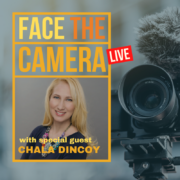Case Study: How to make attention grabbing videos
The key to creating attention grabbing videos
I’ve created a Myth Busting Guide with a set of 5 questions to help you discover how to challenge the myth your customers have about achieving the benefits your business offers.
Click here to get the guide >
Does your business feel like a best kept secret?
Let’s face it. The world is a crowded place. And busy. And loud. Which means your small business can feel pretty hidden. And your work ends up lost in the crowd.
And we spend tons of energy trying to figure out what new technique or new tool will help us break through all the noise.
But the real answer isn’t ‘out there’ (with the latest snap chat type app). It’s inside you. Your beliefs. Your experience. Your unique approach is what will make you and your business stand out.
You want to engage your customers, but you need to attract their attention first. So how exactly do you create attention grabbing videos?
Here’s the thing: start by challenging an assumption that your customers are making about how they can get the benefit that your product offers.
To be clear, I’ll say this again in a different way: You have a product that offers a solution to a problem (a.k.a. the benefit). Your customers have a belief system about how they’ll get that benefit. Often this is a limited belief. And their belief is not the truth.
It’s a myth. And that myth is ripe to be busted wide open.
This is a job for Mythbusters!
(Cue Ghostbusters theme song…)
Bust open one of their myths (one of their core beliefs) and suddenly they’ll be intrigued – by you. You’ve got their attention. Challenge one of their assumptions and they’ll start tuning in to what you’re saying. Change one of their assumptions and they’ll start following you – (on Facebook & Twitter & Youtube).
So, how can you do this?
Here’s a case study, (see the video above), which is one of the finest recent examples of mythbusting, and attention grabbing videos, out there.
Case Study: Like A Girl
 The Like A Girl video (above) works because it breaks one of our collective myths. After watching you’ll probably never use the expression “like a girl” in a negative way — intentionally or not — again.
The Like A Girl video (above) works because it breaks one of our collective myths. After watching you’ll probably never use the expression “like a girl” in a negative way — intentionally or not — again.
The video is striking, and attention grabbing, because it directly challenges our collective myth of what it means to do things “like a girl.” We are shown young individuals (both male and female) standing in front of the camera while being interviewed by documentary filmmaker Lauren Greenfield. (F.Y.I. Greenfield is the Sundance Film Festival award-winning creator of “The Queen of Versailles”).
Greenfield asks each one to act out phrases like “Run like a girl” and “Fight like a girl.” As you might expect, they do a lot of exaggerated limp arm movements and feeble running in place.
This works because we know this is real. We’re seeing honest reactions. And we believe it because we’re seeing people respond to the prompts the same way we would respond. It confirms our mythical image of the true meaning of “like a girl.”
Then, the same question is posed to a group of young girls. And one tiny girl’s unequivocal: “It means to run as fast as you can,” when asked: “What does it mean to you when I say: ‘Run like a girl?’” is especially moving.
You can’t help but feel a swell of pride — as if you were their parent, maybe — as you watch her dart across the screen with purpose and power. (full disclosure: I have an 13 year-old daughter so I got swayed).
The video brilliantly sets up two groups of people. Pre-adolescent girls — and the rest of the world. Ask a young girl how to run or throw like a girl and she, surprise, runs or throws. Period. She gives it her all.
Ask a young boy how to run like a girl and you know what you’re going to get. (the male version of our myth).
But what really makes the video is when women are asked to perform these tasks like a girl. Somewhere between girlhood and womanhood, it turns out, they’ve accepted the boys’ idea of throwing and running and hitting like a girl, and mockingly flop their hands and legs. The contrast makes it all too clear how young women lose self-esteem the more they grow up and hear “like a girl” as a derogatory statement.
All of the above succeeds in flying under the radar of the viewers. We’re no longer watching an ad – or a commercially sponsored video, We’ve become intrigued by the social experiment that’s unfolding before our eyes. And the ultimate pattern interrupt with the question, at 1:06, “When did doing something like a girl become an insult?”
Now we’re hooked.
By busting open our myth about what it means to be “like a girl”, the company who created this video, Always, has now captured our attention and prompted a great conversation, for example: “Why can’t ‘run like a girl’ also mean ‘win the race’?”, (and I really appreciate the shift in this video from social experiments about beauty – as in the Dove Real Beauty campaign – to one about empowerment).
Always succeeded because their #Likeagirl video redefined the myth behind the phrase “like a girl.” They captured attention – 58 million views on Youtube. And they started a great ongoing conversation
Do something attention grabbing to challenge your crowd
What myth can you bust open? What assumptions are your customers making that you can challenge?
I’ve created a Myth Busting Guide with a set of 5 questions to help you discover how to challenge the myth your customers have about achieving the benefits your business offers. Click here to get the guide >
Your Homework
Read the guide & the 5 myth busting questions and come up with a misconception that your crowd has that you can challenge.









